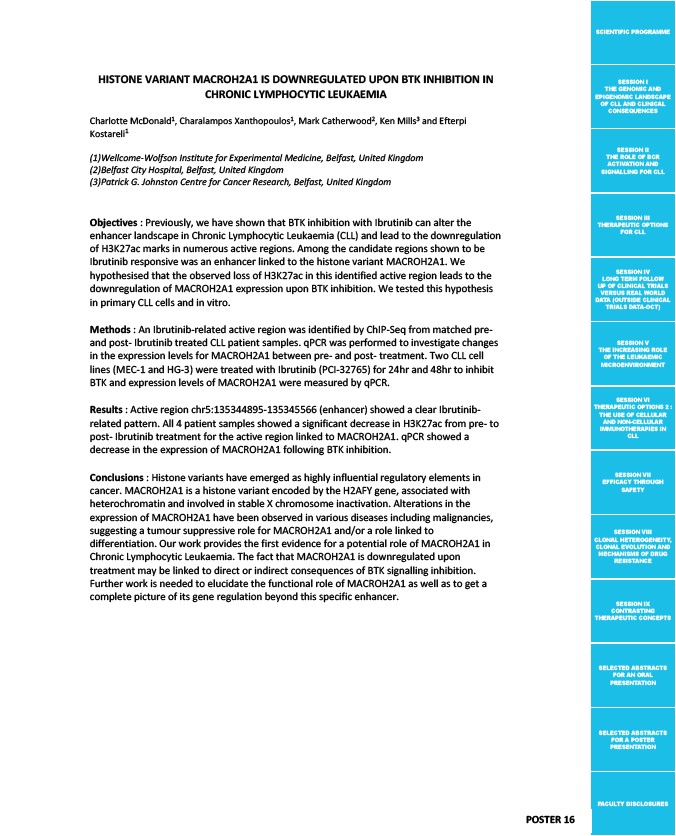
SCIENTIFIC PROGRAMME
SESSION I
THE GENOMIC AND
EPIGENOMIC LANDSCAPE
OF CLL AND CLINICAL
CONSEQUENCES
SESSION II
THE ROLE OF BCR
ACTIVATION AND
SIGNALLING FOR CLL
SESSION III
THERAPEUTIC OPTIONS
FOR CLL
SESSION IV
LONG TERM FOLLOW
UP OF CLINICAL TRIALS
VERSUS REAL WORLD
DATA (OUTSIDE CLINICAL
TRIALS DATA-OCT)
SESSION V
THE INCREASING ROLE
OF THE LEUKAEMIC
MICROENVIRONMENT
SESSION VI
THERAPEUTIC OPTIONS 2 :
THE USE OF CELLULAR
AND NON-CELLULAR
IMMUNOTHERAPIES IN
CLL
SESSION VII
EFFICACY THROUGH
SAFETY
SESSION VIII
CLONAL HETEROGENEITY,
CLONAL EVOLUTION AND
MECHANISMS OF DRUG
RESISTANCE
SESSION IX
CONTRASTING
THERAPEUTIC CONCEPTS
SELECTED ABSTRACTS
FOR AN ORAL
PRESENTATION
SELECTED ABSTRACTS
FOR A POSTER
PRESENTATION
FACULTY DISCLOSURES
HISTONE VARIANT MACROH2A1 IS DOWNREGULATED UPON BTK INHIBITION IN
CHRONIC LYMPHOCYTIC LEUKAEMIA
Charlotte McDonald1, Charalampos Xanthopoulos1, Mark Catherwood2, Ken Mills3 and Efterpi
Kostareli1
(1)Wellcome-Wolfson Institute for Experimental Medicine, Belfast, United Kingdom
(2)Belfast City Hospital, Belfast, United Kingdom
(3)Patrick G. Johnston Centre for Cancer Research, Belfast, United Kingdom
Objectives : Previously, we have shown that BTK inhibition with Ibrutinib can alter the
enhancer landscape in Chronic Lymphocytic Leukaemia (CLL) and lead to the downregulation
of H3K27ac marks in numerous active regions. Among the candidate regions shown to be
Ibrutinib responsive was an enhancer linked to the histone variant MACROH2A1. We
hypothesised that the observed loss of H3K27ac in this identified active region leads to the
downregulation of MACROH2A1 expression upon BTK inhibition. We tested this hypothesis
in primary CLL cells and in vitro.
Methods : An Ibrutinib-related active region was identified by ChIP-Seq from matched pre-
and post- Ibrutinib treated CLL patient samples. qPCR was performed to investigate changes
in the expression levels for MACROH2A1 between pre- and post- treatment. Two CLL cell
lines (MEC-1 and HG-3) were treated with Ibrutinib (PCI-32765) for 24hr and 48hr to inhibit
BTK and expression levels of MACROH2A1 were measured by qPCR.
Results : Active region chr5:135344895-135345566 (enhancer) showed a clear Ibrutinib-related
pattern. All 4 patient samples showed a significant decrease in H3K27ac from pre- to
post- Ibrutinib treatment for the active region linked to MACROH2A1. qPCR showed a
decrease in the expression of MACROH2A1 following BTK inhibition.
Conclusions : Histone variants have emerged as highly influential regulatory elements in
cancer. MACROH2A1 is a histone variant encoded by the H2AFY gene, associated with
heterochromatin and involved in stable X chromosome inactivation. Alterations in the
expression of MACROH2A1 have been observed in various diseases including malignancies,
suggesting a tumour suppressive role for MACROH2A1 and/or a role linked to
differentiation. Our work provides the first evidence for a potential role of MACROH2A1 in
Chronic Lymphocytic Leukaemia. The fact that MACROH2A1 is downregulated upon
treatment may be linked to direct or indirect consequences of BTK signalling inhibition.
Further work is needed to elucidate the functional role of MACROH2A1 as well as to get a
complete picture of its gene regulation beyond this specific enhancer.
POSTER 16